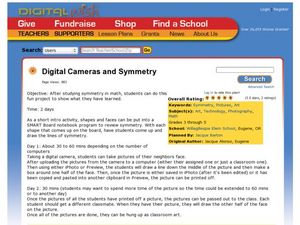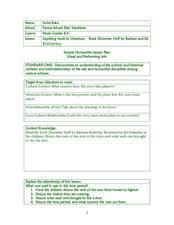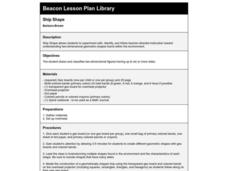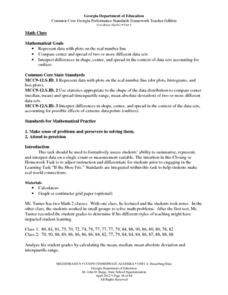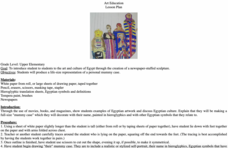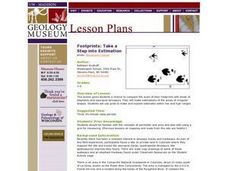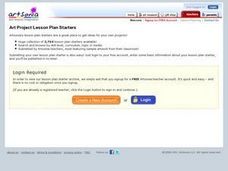Curated OER
Whatever Floats Your Boat
Second graders make boats by folding paper. They identify and draw shapes made during the creating process and place lines of symmetry on them. They demonstrate their understanding by completing an activity sheet imbedded in this plan.
Curated OER
Folded Fractions
Second graders, in pairs, use various geometric shapes to represent fractional parts and divide them into equal parts.
Curated OER
Indirectly Direct
Students use prior knowledge of angle and lines as they conduct an experiment with a rolling marble to determine the shape of a mystery object located under a metal pie tin.
Curated OER
Graphics Integrates Fun
Students take digital pictures of themselves before using a stylus pen on to trace their facial features on a graphic pad. Using an Internet gallery of body drawings they complete a caricature of themselves. In two other activities, they...
Curated OER
Locomotor Letters (Numbers or Shapes)
Students practice a variety of locomotor skills and integrate the writing of numbers, letters and shape drawing. Done with music.
Curated OER
Shaping the View: Composition Basics
Students are introduced to the concept of composition in visual art. They examine various compositional structures and practice identifying the focus of various pieces of art.
Curated OER
Digital Cameras and Symmetry
Students take pictures of shapes and faces they see and draw lines of symmetry in them. In this symmetry lesson plan, students also draw one half of another student's face.
Alabama Learning Exchange
Dog Gone Again!
Here is a real-life lesson! Learners must plan the dimensions of a rectangular fence to reign in a runaway dog. They survey what shape and size fence is needed and use formulas to find perimeter and area of the fence. They explore what...
Curated OER
Applying Music to Literature
Kids explore music, history, culture, and literature in a multi-faceted lesson plan. They discuss how both historical and cultural contexts shape music, art, and literature, and then apply these concepts as they engage in a listening...
Alabama Learning Exchange
Pennies, Pennies and More Pennies
Learners determine the number of pennies needed to fill a room. In this pennies lesson plan, students work in groups to determine the number of pennies needed to fill a room. They compute the probability of the head of a pin...
Curated OER
Polygon Perimeters
Fourth graders practice finding the perimeter of shapes. In this measurement lesson, 4th graders review the meaning of perimeter and work in groups to draw polygons with differing perimeters. Students share their polygons...
Curated OER
Give It a Whirl
Students examine and identify polyhedron shapes on a math website. They write journal reflections about two- and three-dimensional shapes, and transform a square into a pinwheel.
Curated OER
Roger Brown
Students examine and discuss the use of symmetry in a painting by the artist Roger Brown. They draw a geometric shape, divide it with a line of symmetry, and create a painting using the geometric shapes demonstrating symmetry.
Curated OER
So Many Cats!
First graders listen to the book, So Many Cats, and discuss the number of cats in the story. They demonstrate simple addition problems using cat counters and a work mat in the shape of a house.
Curated OER
Ship Shape
Third graders experiment with, identify, and follow teacher-directed instruction toward understanding two-dimensional geometric shapes found within the environment. Groups of students utilize geoboards to help them explain geometric shapes.
Georgia Department of Education
Math Class
Young analysts use real (provided) data from a class's test scores to practice using statistical tools. Not only do learners calculate measures of center and spread (including mean, median, deviation, and IQ range), but...
American Statistical Association
Colors Challenge!
Does writing the name of a color in a different colored ink affect one's ability to read it? Scholars design an experiment to answer this question. They collect the data, analyze the statistics, and draw a conclusion based on...
Statistics Education Web
How High Can You Jump?
How high can your pupils jump? Learners design an experiment to answer this question. After collecting the data, they create box plots and scatter plots to analyze the data. To finish the lesson plan, they use the data to...
Statistics Education Web
Consuming Cola
Caffeine affects your heart rate — or does it? Learners study experimental design while conducting their own experiment. They collect heart rate data after drinking a caffeinated beverage, create a box plot, and draw conclusions....
Curated OER
Egyptian Mummy Cases
Here is an activity I'd like to do with my class! They researching the ins and outs of Egyptian culture, hieroglyphs, symbolism, and art, then use what they know to create realistic or stylized Mummy cases. These cases need to include...
Curated OER
Footprints: Take a Step into Estimation
Compare sizes of student footprints with those of elephants and sauropod dinosaurs! Upper graders make estimations of the areas of irregular shapes; students use grids to make and explain estimates within low and high ranges.
Curated OER
Symmetrical Masks
Fifth graders examine symmetrical and asymmetrical balance while making a mask using a variety of colored pencil and marker techniques. They use the process of revision and design as they complete their masks.
Curated OER
Drawing Straws
Fourth graders examine the Triangle Inequality Theorem by investigating possible lengths of the sides of a triangle.
Curated OER
Symmetry Monsters
Students discuss and study the word symmetry. They examine letters of the alphabet, shapes, and artwork and decide if they are symmetrical or not. Then they create their own symmetry monsters.






